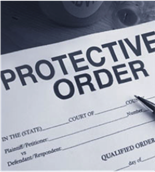By: Carley Ruival
The most widely used legal recourse against domestic violence,1 protective orders are an imperfect remedy that could be substantially improved upon with relatively easy-to-implement changes. Broadly, a protective order is an injunction issued by a court under the applicable laws of the state to prevent someone from engaging in violent or threatening acts, harassment, contact, communication, or physical proximity to another person.2 Nomenclature of this concept varies from state to state; these orders are variously known as protection orders and restraining orders in other jurisdictions. In Virginia, protective orders are defined as “legal documents issued by a judge or magistrate to protect the health and safety of a person who is alleged to be a victim of any act involving violence, force or threat that results in bodily injury or places that person in fear of death, sexual assault or bodily injury.”3 Even though protective orders are a civil remedy, a person who violates a protective order is subject to criminal penalties.4 There are three types of protective orders in Virginia: an emergency protective order, a preliminary protective order, and a “full” protective order (unhelpfully called “protective order” in the Code).5
An emergency protective order lasts for three days and can be issued by any judge of a circuit court, general district court, juvenile and domestic relations court, or magistrate.6 Law enforcement can petition a magistrate or judge for an emergency protective order on a complainant’s behalf.7
A preliminary protective order lasts for up to 15 days or until a full hearing.8 In order to obtain a preliminary protective order, a complainant must file the appropriate petition, typically with the juvenile and domestic relations court when the alleged abuse occurred at the hands of an intimate partner.9 After the paperwork is filed, the complainant typically appears before a judge, who may ask them questions about their allegations in order to determine whether to grant the order.10 In order to grant a preliminary protective order in the context of intimate partner violence, a judge must find that there is immediate and present danger that family abuse has already occurred or will occur.11 Both emergency and preliminary protective orders can be issued ex parte, meaning only one party (the complainant) is present and the other party (the alleged abuser) is not, and indeed may not even have notice that the protective order is being sought.12 After a complainant obtains a preliminary protective order, the next step is obtaining a “full” protective order that lasts a maximum of two years (after which time a complainant can petition to extend the order); this involves a hearing in which both parties are present.13
On one hand, protective orders are a highly-utilized remedy that provide survivors of domestic violence quick access to the courts in their efforts to protect themselves from often life-threatening violence.14 On the other hand, protective orders entail the major disadvantage of requiring continuous contact between the survivor and her abuser in order to keep the order in place.15 This continuous contact comes in the form of the multiple court proceedings required to both obtain and maintain a protective order. Interestingly, the short-term nature of protective orders that require continuous renewal sharply contrast with the widespread availability of permanent injunctions in other areas of law.16 Indeed, “short-term statutory injunctions against domestic violence problematically give the appearance of remedying domestic abuse while permitting domestic violence to continue.”17
A simple remedy to this problem (at least for the narrow class of complainants who seek permanent judicial intervention) is the creation of a permanent protective order available to victims of domestic violence. By implementing this change, survivors of domestic violence are permitted to avoid the ironic predicament of forced repeated contact with the very abusers they are seeking a protective order to avoid. Under this approach, permanent protective orders would replace “full” protective orders that last only two years as the default remedy, with the option for the complainant to amend the order to make it temporary. As the option to extend protective orders after two years already exists,18 this proposal does not require massive overhaul of the existing law; it merely changes the default remedy in a way that is more consistent with the public policy rationale behind protective orders: affording protection to victims of domestic violence.
1 Jane K. Stoever, Enjoining Abuse: The Case for Indefinite Domestic Violence Protection Orders, 67 Vand. L. Rev. 1015, 1019 (2014).
2 Nancy K.D. Lemon, Domestic Violence Law, 274 (West Academic, 5th ed. 2018).
3 What You Need to Know About Protective Orders, Virginia Court System, https://www.vacourts.gov/forms/district/info_sheet_protective_order_stalking.pdf (last visited Feb. 21, 2022).
4 Va. Code Ann. § 16.1-252.3 (2021 Reg. Sess.).
5 What You Need to Know About Protective Orders, Virginia Court System, https://www.vacourts.gov/forms/district/info_sheet_protective_order_stalking.pdf (last visited Feb. 21, 2022).
6 Va. Code Ann. § 16.1-252.4 (2021 Reg. Sess.).
7 See id.
8 What You Need to Know About Protective Orders, Virginia Court System, https://www.vacourts.gov/forms/district/info_sheet_protective_order_stalking.pdf (last visited Feb. 21, 2022).
9 Id.
10 Id.
11 Va. Code Ann. § 16.1-253.1 (2021 Reg. Sess.).
12 See id.
13 Va. Code Ann. § 16.1-279.1 (2022 Reg. Sess.).
14 See Jane K. Stoever, Enjoining Abuse: The Case for Indefinite Domestic Violence Protection Orders, 67 Vand. L. Rev. 1015, 1019 (2014).
15 See id at 1021.
16 Id at 1022.
17 Id.
18 Va. Code Ann. § 16.1-279.1(B) (2022 Reg. Sess.).